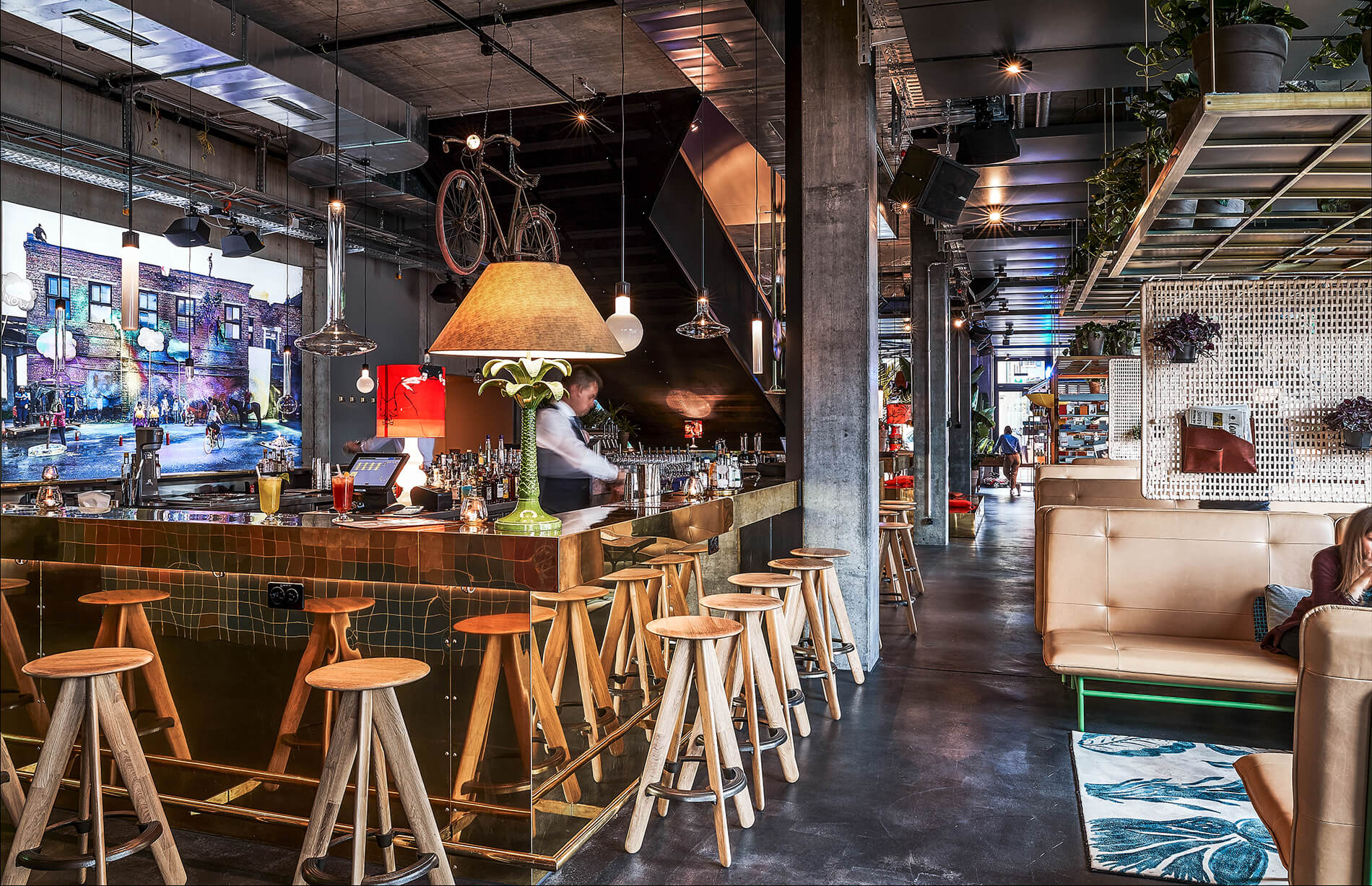As the founder of the gastronomy concept development company Recipe for Concept, Jan Smeets always has his eye on the international market, because the ideas he and his team develop for customers have to have a future. His concepts give his clients a framework, and he’s trying to help them get ahead, not drive them into ruin. But how does he know which ideas will hold up in the face of future developments? The Dutchman is one of the most experienced concept developers in the entire industry—he’s been working in the gastro industry since 20 years and as a concept consultant and a food-and-beverage scene analyst for 8 years now.

Image: Jan Smeets
Jan, how do you know which ideas are going to work in the future? Crystal ball, maybe?
Jan Smeets: Hm… I would like a crystal ball. Or not, is pretty boring… Even without one I’m really convinced that future food-and-beverage concepts will all have one thing in common: a surprise factor. Every concept has to provide that. Of course, for an idea to work, it also has to be 100% believable. Whenever you’re starting something new, you have to be able to answer a lot of questions. What do I want this food and beverage concept to achieve? What’s its target group? What kinds of things are possible in my location? What is the competition doing? And as far as innovation goes, another important one is: how much courage do I have to do something new and different?
To be able to predict what the future will bring, you have to know how to assess the here and now. So what’s your take on the world’s major markets? Asia, America, Europe…?
Jan Smeets: That’s a big question. Actually, though, I wouldn’t distinguish among the different markets. Thanks to globalization, you can say the same thing about markets all over the world: digitization is both helping the industry advance and holding it back. Every new F&B project we encounter has to keep the same basic things in mind, like the fact that having qualified staff available will allow them to simplify their kitchen and service processes, or asking themselves how effective, user-friendly equipment can support them. Hopefully working in eco-friendly, resource-conserving ways will soon become an equally important consideration. Energy-efficient equipment is key there, and so is having a well-thought-out environmental concept. And reducing waste is a huge topic… or maybe I should say a huge dilemma…
…even in smaller countries, which is where a lot of big trends have come from in recent years. Will ideas from island worlds like Hawaii, or from African nations, play a bigger role in the future?
Jan Smeets: Sure. Poke and ceviche are both huge trends right now. Nobody can predict for sure how those will develop. Sushi, for example, used to be a big trend, and nowadays it’s standard. On the other hand, concepts like Trader Vic’s have been hugely successful for decades now, but there’s never been a lot of hype around them. Whether unfamiliar ideas will catch on in the future will depend on how curious consumers are and how experimentally minded restaurateurs are. Right now, both groups are focused on regional food, clean eating, and vegetarian/vegan options—and that’s true worldwide, too.
Revolution starts with emotion
Where do revolutionary trends within the industry come from, if not from concept development agencies like yours?
Jan Smeets: Wow… There’s no short answer to that. Revolutionary trends develop out of everything that happens in the world, including things that have nothing to do with the industry itself.
What becomes trendy always depends on what’s already around. For example, what kinds of things are possible with (new) culinary technologies, or new developments in the food industry? What products have become available? How are consumers’ habits changing? When are people eating how, and where? Where are people getting their food from, both within and outside of major cities? And all of that is connected to economic and societal changes, too.
Technologically speaking, digitization is going to continue having a huge influence on the world. But there could be a kind of backlash, too—sort of a de-digitization, maybe?
Demographic developments will play a part in future mega-trends, too. Maybe with the way age demographics are shifting, it’ll be less about revolutionizing and more about reviving or re-interpreting old favorites? We’re already seeing a trend back toward simplicity and familiarity. I would love for things to develop in the direction of “simple but good”, and it would be great if people would stop evaluating food and drink quality based on quantity and price.
Sounds like the industry is facing some big challenges. What would you say new concepts will need to focus on?
Jan Smeets: First of all, as a professional concept developer, I feel like concepts need to be more thought-out in general. In the future, we’re going to need concepts that place a greater emphasis on the customer experience and tie it into authentic storytelling. People aren’t there just to consume. They want stories. Appealing to customers’ emotions will be the key to long-term success in the future. And it’s crucial that customers feel like the overall package is relevant to them—otherwise they won’t be interested.
Do today’s young professionals define the trends of tomorrow?
Jan Smeets: Of course they’re going to make huge contributions in that regard—they help inspire the whole industry! But a lot needs to change in the gastronomy world to help encourage and keep creative, motivated, and enthusiastic young talent. Many of the best, most creative approaches are borne of necessity, but that doesn’t mean we have to just sit back and take our chances of that happening.
Where do you think the F&B sector will be in 10 years? What’s going to change the most? Interiors? Food and beverage selections? Or maybe equipment customers don’t see, like technologies or features in the kitchen or behind the counter?
Jan Smeets: The lack of qualified personnel is becoming more drastic throughout the industry, so user-friendliness, economic efficiency, and functionality are becoming more and more important qualities in kitchen and bar equipment. What tasks and processes can we automate or digitize?
How experimentally minded would you say consumers are? Will we still be eating meat and fish in 10 years, or will everyone be cooking vegan?
Jan Smeets: That’s one we should ask the crystal ball! I think there’s going to be more of an emphasis on vegetarian and vegan products—they’ll become far more mainstream than they are in a lot of places right now. They’ve got what it takes to become the real stars of a dish. Vegetarian and vegan cuisine offers so much more variety than most of us even realize. It still has the power to surprise us. Just look at everything people are doing with celery these days. Chefs are serving it smoked, dried, as a concentrated jus, vacuum-cooked… the list goes on.
We’ll probably still be eating meat and fish in ten years. Less of it, but of better quality, and—this is important—less controversial. It may sound naive, but I’d love if we could all ban discount meat from factory farms. Obviously, that means we’ll have to find other sources of protein. Personally, though, I’m hoping that the trend of using insects as a replacement protein source won’t catch on. I still think that’s kind of gross, and I’m okay with that for now…
Do you think we’ll still be drinking wine in the future? Will bartenders still be serving gin, or will we all be on non-alcoholic ginger-ale cocktails in ten years?
Jan Smeets: Of course we’ll still be having wine with our dinners. Maybe we’ll even go back to drinking wine from traditional regions again. It’s true, though: There are a number of exciting alternatives that bartenders and restaurateurs can work with, and hopefully they will offer much more in the future.
Craft beer, for example: there are so many tasty, original brews out there, so why aren’t they more popular than they are? I think things will only better in the future in that regard. And in the high-end gastronomy world, we definitely need more variety in terms of food pairings. There are so many exciting new specialty concoctions out there: cuvées, infusions, teas, brews, you name it. Enough with the same old, same old. Like I said, consumers want new options, and future consumers will be even more adamant about it.
Successful food and beverage concepts in the future will either be extremely specialized—whether it’s in gin, rum, or tequila—or else just the opposite, they’ll be really experimental in terms of new combinations, original ingredients, and innovative techniques.
What would you say young kitchen rebels should focus on if they want to be successful in the future? Are there leading heads? Leading regions or countries?
Jan Smeets: Right now, the leading heads and regions are in the North, in Scandinavia. But you can find inspiration all over the world, near or far. To get the experience they’ll need to become trendsetters, I recommend younger folks travel a lot and try a lot of new things, and be open to new ideas as well as traditional ones.
Where do customers fit into all this? Are they drivers of change, too, or do they pretty much just eat what’s put in front of them?
Jan Smeets: If you don’t have customers, you don’t have a business. Customers are the ones who decide what’s put in front of them and how. Maverick ideas only succeed through customers that are open to them. We can expect more of those types of customers in the future, though, so chefs will be free to create things that diners won’t expect, that they don’t know, that they’ll be surprised by. New and unexpected experiences. So go ahead and be original, but don’t force anything onto customers…
you have to maintain a balance between what you want to do and what your customers want you to do. Both are important in shaping the future.
Thanks very much for your thought-provoking answers!
















